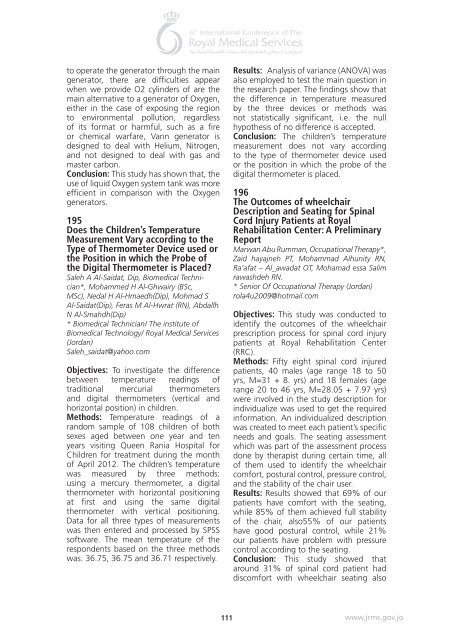Abstract book 6th RMS 16.indd
Abstract book 6th RMS 16.indd
Abstract book 6th RMS 16.indd
You also want an ePaper? Increase the reach of your titles
YUMPU automatically turns print PDFs into web optimized ePapers that Google loves.
to operate the generator through the main<br />
generator, there are difficulties appear<br />
when we provide O2 cylinders of are the<br />
main alternative to a generator of Oxygen,<br />
either in the case of exposing the region<br />
to environmental pollution, regardless<br />
of its format or harmful, such as a fire<br />
or chemical warfare, Vann generator is<br />
designed to deal with Helium, Nitrogen,<br />
and not designed to deal with gas and<br />
master carbon.<br />
Conclusion: This study has shown that, the<br />
use of liquid Oxygen system tank was more<br />
efficient in comparison with the Oxygen<br />
generators.<br />
195<br />
Does the Children’s Temperature<br />
Measurement Vary according to the<br />
Type of Thermometer Device used or<br />
the Position in which the Probe of<br />
the Digital Thermometer is Placed?<br />
Saleh A Al-Saidat, Dip, Biomedical Technician*,<br />
Mohammed H Al-Ghwairy (BSc,<br />
MSc), Nedal H Al-Hmaedh(Dip), Mohmad S<br />
Al-Saidat(Dip), Feras M Al-Hwrat (RN), Abdallh<br />
N Al-Smahdh(Dip)<br />
* Biomedical Technician/ The institute of<br />
Biomedical Technology/ Royal Medical Services<br />
(Jordan)<br />
Saleh_saidat@yahoo.com<br />
Objectives: To investigate the difference<br />
between temperature readings of<br />
traditional mercurial thermometers<br />
and digital thermometers (vertical and<br />
horizontal position) in children.<br />
Methods: Temperature readings of a<br />
random sample of 108 children of both<br />
sexes aged between one year and ten<br />
years visiting Queen Rania Hospital for<br />
Children for treatment during the month<br />
of April 2012. The children’s temperature<br />
was measured by three methods:<br />
using a mercury thermometer, a digital<br />
thermometer with horizontal positioning<br />
at first and using the same digital<br />
thermometer with vertical positioning.<br />
Data for all three types of measurements<br />
was then entered and processed by SPSS<br />
software. The mean temperature of the<br />
respondents based on the three methods<br />
was: 36.75, 36.75 and 36.71 respectively.<br />
Results: Analysis of variance (ANOVA) was<br />
also employed to test the main question in<br />
the research paper. The findings show that<br />
the difference in temperature measured<br />
by the three devices or methods was<br />
not statistically significant, i.e. the null<br />
hypothesis of no difference is accepted.<br />
Conclusion: The children’s temperature<br />
measurement does not vary according<br />
to the type of thermometer device used<br />
or the position in which the probe of the<br />
digital thermometer is placed.<br />
196<br />
The Outcomes of wheelchair<br />
Description and Seating for Spinal<br />
Cord Injury Patients at Royal<br />
Rehabilitation Center: A Preliminary<br />
Report<br />
Marwan Abu Rumman, Occupational Therapy*,<br />
Zaid hayajneh PT, Mohammad Alhunity RN,<br />
Ra’afat – Al_awadat OT, Mohamad essa Salim<br />
rawashdeh RN.<br />
* Senior Of Occupational Therapy (Jordan)<br />
rola4u2009@hotmail.com<br />
Objectives: This study was conducted to<br />
identify the outcomes of the wheelchair<br />
prescription process for spinal cord injury<br />
patients at Royal Rehabilitation Center<br />
(RRC).<br />
Methods: Fifty eight spinal cord injured<br />
patients, 40 males (age range 18 to 50<br />
yrs, M=31 + 8. yrs) and 18 females (age<br />
range 20 to 46 yrs, M=28.05 + 7.97 yrs)<br />
were involved in the study description for<br />
individualize was used to get the required<br />
information. An individualized description<br />
was created to meet each patient’s specific<br />
needs and goals. The seating assessment<br />
which was part of the assessment process<br />
done by therapist during certain time, all<br />
of them used to identify the wheelchair<br />
comfort, postural control, pressure control,<br />
and the stability of the chair user.<br />
Results: Results showed that 69% of our<br />
patients have comfort with the seating,<br />
while 85% of them achieved full stability<br />
of the chair, also55% of our patients<br />
have good postural control, while 21%<br />
our patients have problem with pressure<br />
control according to the seating.<br />
Conclusion: This study showed that<br />
around 31% of spinal cord patient had<br />
discomfort with wheelchair seating also<br />
111 www.jrms.gov.jo

















